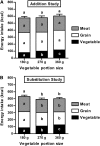Portion size can be used strategically to increase vegetable consumption in adults
- PMID: 20147467
- PMCID: PMC2844679
- DOI: 10.3945/ajcn.2009.28801
Portion size can be used strategically to increase vegetable consumption in adults
Abstract
Background: An increase in the proportion of vegetables at meals could help achieve recommended vegetable intakes and facilitate weight management.
Objective: We investigated the effects on food and energy intakes of varying the portion size and energy density of a vegetable that was added to a meal or substituted for other foods.
Design: In 2 experiments with crossover designs, men and women were served a meal of a vegetable, grain, and meat. Across the meals, the vegetable was served in 3 portion sizes (180, 270, or 360 g) and 2 energy densities (0.8 or 0.4 kcal/g) by altering the type and amount of added fat. In the addition study (n = 49), as the vegetable portion was increased, amounts of the grain and meat were unchanged, whereas in the substitution study (n = 48), amounts of the grain and meat decreased equally.
Results: An increase in the vegetable portion size resulted in greater vegetable consumption in both studies (mean +/- SE: 60 +/- 5 g; P < 0.0001). The addition of more of the vegetable did not significantly affect meal energy intake, whereas substitution of the vegetable for the grain and meat decreased meal energy intake (40 +/- 10 kcal; P < 0.0001). A reduction in vegetable energy density decreased meal energy intake independent of portion size (55 +/- 9 kcal; P < 0.0001). By combining substitution with a reduction in energy density, meal energy intake decreased by 14 +/- 3%.
Conclusions: Serving more vegetables, either by adding more or substituting them for other foods, is an effective strategy to increase vegetable intake at a meal. However, to moderate meal energy intake, vegetables should be low in energy density; furthermore, the substitution of vegetables for more energy-dense foods is more effective than simply adding extra vegetables.
Figures



References
-
- Guenther PM, Dodd KW, Reedy J, Krebs-Smith SM. Most Americans eat much less than recommended amounts of fruits and vegetables. J Am Diet Assoc 2006;106:1371–9 - PubMed
-
- Blanck HM, Gillespie C, Kimmons JE, Seymour JD, Serdula MK. Trends in fruit and vegetable consumption among U.S. men and women, 1994–2005. Prev Chronic Dis 2008;5. Available from: http://www.cdc.gov/pcd/issues/2008/apr/07_0049.htm (cited 5 October 2009) - PMC - PubMed
-
- US Department of Health and Human Services and US Department of Agriculture Dietary Guidelines Advisory Committee. Report of the Dietary Guidelines Advisory Committee on the Dietary Guidelines for Americans, 2005. January 2005. Available from: http://www.health.gov/dietaryguidelines/dga2005/report/ (cited 5 October 2009)
-
- Rolls BJ, Ello-Martin JA, Tohill BC. What can intervention studies tell us about the relationship between fruit and vegetable consumption and weight management? Nutr Rev 2004;62:1–17 - PubMed
Publication types
MeSH terms
Substances
Grants and funding
LinkOut - more resources
Full Text Sources
Medical

